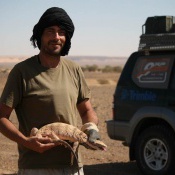METALAND: Inferring metapopulation dynamics with landscape genetics for vertebrates of Mauritanian mountains
Mauritania is located in a biogeographical crossroad between the Palaearctic and Afro-tropical regions in West Africa, which results in the occurrence of species with distinct biogeographical affinities, including Mediterranean, Saharo-Sindian, Sahelian and Afro-tropical. Consequentially, complex patterns of species distribution and local high species richness may be found. The mountains of Adrar Atar, Tagant, Assaba and Afollé are a noticeable species-rich area. Due to alternate historical phases of dry and humid climate in the Sahara, these mountains hold isolated populations of several vertebrates.
The current dry stage of the Sahara confines these populations to humid and fragile habitats, such as mountain lagoons (gueltas) or seasonal floodplain (tâmoûrts), rendering populations vulnerable to extinction. However, suitable corridors for dispersal are formed during the rainy season, along raging streams that usually flow to vast plains adjacent to the rock pools, which could inter-connect some of the isolated habitats. Therefore, it can be formulated the hypothesis that dispersal through temporary suitable corridors, with associated gene flow, might attenuate loss of genetic diversity within isolated populations.
This project aims to investigate biogeographical and evolutionary patterns in vertebrates of Mauritania. At a macro-scale (Mauritania), species distribution data of fishes, amphibians, reptiles and mammals are being combined with genetical variability and analysed with Geographical Information Systems (GIS) and ecological modelling in order to: 1) map species distribution and identify biodiversity hotspots; 2) identify environmental factors related with species occurrence and derive models of species-richness distribution; 3) evaluate the effects of climate change on current diversity patterns; 4) uncover phylogenetic relationships and derive historical biogeographical scenarios.
At a micro-scale (mountains), species distribution data of selected vertebrates, including fishes (Barbus pobeguini, Tilapia sp.), amphibians (Amietophrynus xeros, Hoplobatrachus occipitalis) and reptiles (Crocodylus suchus) are being combined with genetical variability and analysed with GIS ecological modelling in order to: 5) identify environmental factors related with species occurrence and locate corridors suitable for dispersal between gueltas; 6) determine the role of unpredictable micro-scale events of gene flow in the dynamics of these probable metapopulations.
The project develops innovative scientific research in desert environments by combining cutting-edge molecular and spatial analyses to derive a landscape metapopulation model. Molecular analyses are expected to allow answering the following questions: what is the level of genetic differentiation of isolated populations? Is genetic variability spatially structured? Does gene flow occur? Are there species-specific differences in gene flow? Spatial analyses are expected to allow answering the questions: Where are located habitats with permanent and temporary water? Where are located suitable corridors for dispersal? Are there least-cost connection pathways? A landscape model is expected to allow answering the questions: Where are located areas of high genetic variability? Are there multivariate clines in the distribution of genetic variability? Where are located barriers in the landscape for gene flow? Are gene flow levels related to least-cost connection paths?
The project will give an insight about metapopulation dynamics in the Sahara desert environment, and will contribute to strengthen the present knowledge on evolutionary and adaptation mechanisms to extreme arid conditions. Furthermore, results will provide basic information to evaluate species conservation status, develop conservation strategies and establish local protected areas.
André Ribeiro da Silva de Almeida Marçal, Maria Judite Silva Cardoso Alves, José Alberto Álvares Pereira Gonçalves, Natacha Pio Mesquita, Elsa Maria Branco Froufe Andrade, Neftalí Sillero Pablos, Pierre-Andre Crochet



